July 1st Scots Book of Days
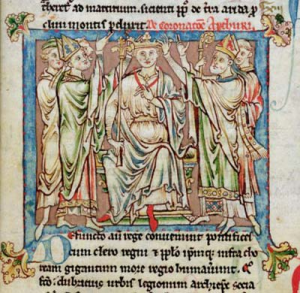 July 1 – 572 Battle of Arthuret. sometime this year. First mention of a historical King Arthur comes from a Scottish poem ‘The Goddodin’. King of Strathclyde. www.scotland.com/forums/history/ 24886-king-arthur-fact-fiction.html
July 1 – 572 Battle of Arthuret. sometime this year. First mention of a historical King Arthur comes from a Scottish poem ‘The Goddodin’. King of Strathclyde. www.scotland.com/forums/history/ 24886-king-arthur-fact-fiction.html
The Gododdin, known in Roman times as the Votadini, held territories in what is now southeast Scotland and Northumberland, part of the Hen Ogledd (Old North). The poem tells how a force of 300 (or 363) picked warriors were assembled, some from as far afield as Pictland and Gwynedd. After a year of feasting at Din Eidyn, now Edinburgh, they attacked Catraeth, which is usually identified with Catterick, North Yorkshire. The poem is dated from 7th to 12th century. Wikipedia.
King Arthur, miniature from “Flores Historiarum,” by Matthew Paris, c.1250-52 (vellum)
English School/The Bridgeman Art Library/Getty Images.
Some parallels are in this story to that of Gideon in the Book of Judges, when 300 picked soldiers armed with horns, lamps and pitchers, and the Lord, delivered Israel from the Midian army [cousins as both were descendants of Abraham and Keturah Genesis 25 v. 2).
Tytler’s History of Scotland from Encyclopeadia Britannica
CHRONOLOGY OF THe PERIOD.
A.D. 1307. sometime this year. Edward II. king of England; (ancestor of both Scots and English royal lines, and descent from Malcolm King of Scots). Swiss republics established (Republic means no king) with William Tell the hero.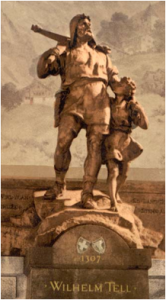
www.greatkat.com Wilhelm Tell (German spelling) 1307. Tell assassinated a member of the Austria Hapsburg family, whose descendant Philip II of Spain was King consort Philip 1 of Mary of England (1554-1558, known as Mary 1, after 1688). Philip II attempted the Spanish Armada invasion (1585), with part of the fleet crashing into Scotland.
- A.D. sometime this year. The seal of the Pope transferred from Rome to Avignon for seventy years. Scotland was a majority Catholic country until 1560.
- A.D. sometime this year. Rhodes taken by the Knights of St John.
1312 A.D. sometime this year. Order of the Knights Templars suppressed in France and Europe. Knights Templars fleeing France after the Philip IV’s persecution went to Switzerland and Scotland (accepted by Robert the Bruce) and Portugal.
1319 A.D. sometime this year. University of Dublin, Ireland founded.
1327 A.D. sometime this year. Edward III king of England. (ancestor of both Scots and English royal lines, descended from Duncan King of Scots)
1328 A.D. sometime this year. Philip VI. (de Valois) king of France
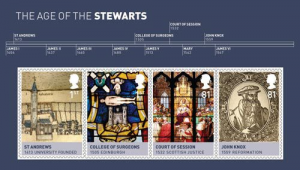 1505 Edinburgh Council granted a charter to the “Barber Surgeons” of Edinburgh, and were formally incorporated as a Craft Guild of Edinburgh. James IV of Scotland granted a royal charter in 1506, enabling them to practice surgery within the city boundary and creating the basis for the Royal College of Surgeons of Edinburgh. postalheritage.wordpress.com
1505 Edinburgh Council granted a charter to the “Barber Surgeons” of Edinburgh, and were formally incorporated as a Craft Guild of Edinburgh. James IV of Scotland granted a royal charter in 1506, enabling them to practice surgery within the city boundary and creating the basis for the Royal College of Surgeons of Edinburgh. postalheritage.wordpress.com
1st class Founding in 1413 of St Andrews University and in 1505 of the College of Surgeons in Edinburgh. 81p 1532 development of the Scottish legal system of justice (the Court of Session), & John Knox, a leading figure in the Reformation of the Church of Scotland in 1559. Issued 23 march 2010.
1543- Treaty of Greenwich Contains two agreements that attempts to unite the Kingdom of England with the Kingdom of Scotland. Rejected.
 1559 Knox preached from the pulpit of St Giles’, the most influential in the capital.
1559 Knox preached from the pulpit of St Giles’, the most influential in the capital.
‘John Knox Preaching before the Lords of the Congregation’ by Sir David Wilkie. The Lords of the Congregation is the name given to Protestant nobles who defended the Protestant clergy after the iconoclastic riot at Perth in May 1559. The ‘first bond [or band] of the Lords of the Congregation of Christ’ was signed in December 1557 in protest at the negotiations by Mary of Guise to marry Mary Queen of Scots to the Dauphin of France. The signatories were Archibald 5th Earl of Argyll, his son Lord Lorne, Alexander Cunningham 5th Earl of Glencairn,
Cunningham of Caprington 1162 2Stewart2Miller 2Simmons2Choate zoe
James Douglas 4th Earl of Morton, and John Erskine, 6th Lord Erskine. Later bonds attracted further signatories including Grey Colin and Patrick Ruthven. It was this group which supported John Knox in 1559 who are known as the Lords of the Congregation.
- Douglas 1036 2Stewart 2Ruthven 2Kinchin 2Jared 2Simmons 2Choate – Douglas 2Montgomberie 2Blair 2Cochrane 2Miller 2Simmons 2Choate – Douglas 2Hamilton 2Stewart 2Miller 2Simmons 2Choate – Douglas 2Carlyle 2Semple 2Montgomery 2Cochrane 2Miller 2Simmons 2Choate
1559 Kirkcaldy of Grange, leader of the Congregation, wrote letter to Sir Henry Percy, to explain if the regent (Queen dowager Mary) would reform to the Word of God, cleanse the churches of idolatry, received the Book of Common Prayer of Edward 6th to be read, send away the French troops, the congregation would obey and serve her, and annex the whole revenues of the abbeys to the crown. Tytler’s Britannica 154.
1622 William Parker, 13th Baron Morley 4th Baron Monteagle (1575– 1 July 1622) was an English peer, Lord of Morley, Hingham, Hockering, &c., in Norfolk, the eldest son of Edward Parker, 12th [Baron Morley who died 1618], and of Elizabeth Stanley, daughter and heiress of William Stanley, 3rd Baron Monteagle (died 1581).
1643 first meeting of the Westminster Assembly.
1669 Indulgence of clergy after Presbytery was abolished TG 50-209.
1673 – On 1 July, 1673, the Register of the Privy Council 3rd series, Vol. IV, p. 71 records that certain indulged ministers have failed to observe the anniversary of the King’s birth and restoration: ‘the 12 act of the third session of the second Parliament it is statut and ordinit that the anniversary solemnitie for his Majesties happy birth and restauration shall in all tym comeing be keeped upon the 29th day of May yearlie throwout the whole kingdome, and that all ministers within the same shall preach yearly upon the said day, that they with the whole people may give thankes to God for his so signall goodnesî. The fine for non- (YYMA 73) observance was half of the stipend allowed them for the current year. Twenty-seven men were cited, among them Robert Miller (I) of Ochiltree
Brought before the Council, some alleged that they had not received the instructions dated the third of the previous September; the Council there and then ordered copies to be brought, and distributed them to the accused at the bar, so that thereafter ‘they might pretend no ignorance of the same.’
On Robert Miller 1st of Ochiltree return from abroad, Robert Miller (I) of Ochiltree married Grizel, daughter of Colonel Hugh Cochrane, and Joan Savage (p. 59, 73) HUGH was the brother of William, 1st Earl of Dundonald. Their children were Robert (II) and John, both of whom became ministers; William who became a doctor; Hugh; Margaret; Katherine; Mary; and Jean. The Index to the Register of Deeds mentions Robert Miller (I) in transactions dated 1669, 1673 and 1677, and his son William in 1685. His brother Henry appears in 1671.
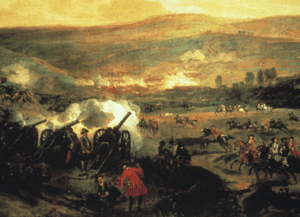 1690 Battle of the Boyne Near Drogheda, Ireland. Glorious Revolution
1690 Battle of the Boyne Near Drogheda, Ireland. Glorious Revolution
The Battle of the Boyne, 1 July 1690 (O.S) – 12 July (N.S). As depicted by Jan Wyck.
leagueofaugsburg.blogspot.com Royal Scots regiment was represented at the Battle of the Boyne (1690) by its 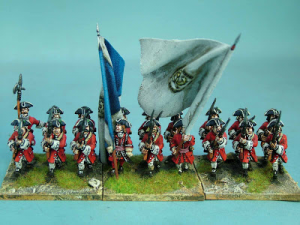 Colonel, the Duke of Schomberg. James had fled to Ireland and formed a army there; William had led his own army to meet and defeat James. James’ forces were in a good defensive position at the Boyne River, and William sent his army forward to force a crossing, and then destroy the Irish. Hard pushed by Irish soldiers at the Boyne Schomberg rallied William’s army, and was killed.
Colonel, the Duke of Schomberg. James had fled to Ireland and formed a army there; William had led his own army to meet and defeat James. James’ forces were in a good defensive position at the Boyne River, and William sent his army forward to force a crossing, and then destroy the Irish. Hard pushed by Irish soldiers at the Boyne Schomberg rallied William’s army, and was killed.
1731 Admiral Adam Duncan born in Dundee. Scottish sailor, age 15 midshipman Royal navy. Duncan went on to command ‘HMS Blenheim’ at the relief of Gibraltar in October 1782, but his greatest moment was the victory over the Dutch at the battle of Camperdown in 1797, and awarded the title of Viscount Duncan of Camperdown. www.bbc.co.uk/scotland/history/onthisday/july/
 1739 The Black Watch (Royal Highland Regiment) (1725 – 2006)
1739 The Black Watch (Royal Highland Regiment) (1725 – 2006)
Soldier of the Black Watch c. 1740
1746 July 1 Started in the early morning, by boat, from Portree (traditionally from Sgeir Mhor), for Raasa Island, conducted by Murdoch· MacLeod of Raasa and
Malcolm MacLeod, and spent this and the following day at Glam, in Raasa. John MacLeod, younger of Raasa, was also in the boat (r. 131,302). At Portree Flora MacDonald parted from the Prince and was taken prisoner eight or ten days after (I. 303). Publications OF THE SCOTISH HISTORY SOCIETY VOLUME XXIII, Pg 69 (54) April 1897 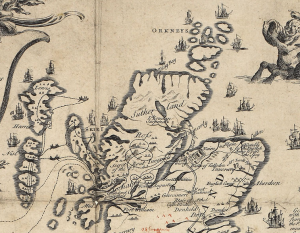 SUPPLEMENT LYON IN MOURNING PRINCE CHARLES EDWARD STUART ITINERARY AND MAP. Ed.W. B. BLAIKIE, from Narrative of Lord MacLeod, son of the Earl of Cromarty
SUPPLEMENT LYON IN MOURNING PRINCE CHARLES EDWARD STUART ITINERARY AND MAP. Ed.W. B. BLAIKIE, from Narrative of Lord MacLeod, son of the Earl of Cromarty
Islands
1747 Louis 15th the Scottish Company numbered 21 officers and 330 men in a mounted unit which last saw active service when they escorted Louis 15th at the Battle of Lawfeld on 1 July 1747. The Scottish Company carried claymores with steel basket guards instead of the swords of the other French heavy cavalry. They were distinguished from the other companies of the Body Guards by wearing white bandoleers garnished with silver lace.
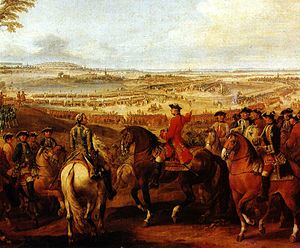 Marshal Maurice de Saxe at the Battle of Lauffeldt. Contemporary painting by Pierre Lenfant. (Galerie des Batailles, Palace of Versailles), father of the namesake for L’Enfant Plaza exit on the Washington D.C. metro.
Marshal Maurice de Saxe at the Battle of Lauffeldt. Contemporary painting by Pierre Lenfant. (Galerie des Batailles, Palace of Versailles), father of the namesake for L’Enfant Plaza exit on the Washington D.C. metro.
1776– The Continental Congress adopts a resolution severing ties with 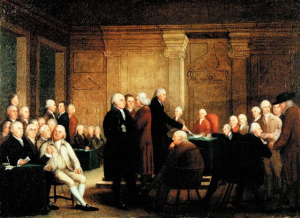 the Kingdom of Great Britain although the wording of the formal Declaration of Independence is not approved until July 4. Congress voting independence. 40% of the founding fathers have Scots ancestry.
the Kingdom of Great Britain although the wording of the formal Declaration of Independence is not approved until July 4. Congress voting independence. 40% of the founding fathers have Scots ancestry.
1787 Sir James Hunter-Blair, 1st Baronet died (February 1741 – 1 July 1787). a Scottish banker and politician. Member of Parliament for Edinburgh from 1780 to 1784 and Lord Provost of Edinburgh in 1784. Hunter Blair cordially received Robert Burns when the poet first arrived in Edinburgh. On Hunter Blair’s death, Burns drafted a somewhat stilted elegy, beginning: ‘The lamp of day, with ill-presaging glare’, Ferguson describes it, justifiably as ‘the disastrous Elegy on the Death of Sir James Hunter Blair’.
 1794 The Gordon Highlanders (1881 – 1994) the 92nd Gordon Highlanders. The 92nd were raised as the 100th Highlanders by the Duke of Gordon in 1794 being renumbered 92nd in 1798. Their early service included the Low Countries and Egypt, followed by Corunna, the Peninsula, Waterloo, Afghanistan and South Africa. 92nd Highlanders at Kandahar by Richard Caton Woodville (1856-1927)
1794 The Gordon Highlanders (1881 – 1994) the 92nd Gordon Highlanders. The 92nd were raised as the 100th Highlanders by the Duke of Gordon in 1794 being renumbered 92nd in 1798. Their early service included the Low Countries and Egypt, followed by Corunna, the Peninsula, Waterloo, Afghanistan and South Africa. 92nd Highlanders at Kandahar by Richard Caton Woodville (1856-1927)
1831 Archibald Cochrane, 9th Earl of Dundonald died (1 January 1748 – 1 July 1831) He joined the British Army as a youth and also served time in the Royal Navy before returning to Culross in 1778 after inheriting the Earldom of Dundonald from his father. Cochrane’s most noted invention was a method for making coal tar (patented in 1781) on an industrial scale. The British Tar Company invested in a works; it was managed by John Loudon McAdam. The coke byproduct was used, in part, by an ironworks at Muirkirk. McAdam bought the company, but the deal was troubled.[2]
Cochrane hoped that he would be able to sell tar as a sealant for the hulls of ships to the Royal Navy. After contacts with the British Admiralty were made, a test was performed on a buoy. The buoy was coated on one side and left uncoated on the other. After some time the uncoated half was leaking and full of worms and  barnacles, while the treated half was in quite good condition. A patent for his invention was drawn up, while the family estates were used as collateral. The coal tar technique was a rival to copper sheathing, preferred by the Admiralty, who profited from repairs. At any one time, a quarter of the fleet was dry docked for repair. Powerful interests in shipyards needed the maintenance business. The patent expired, and the Royal Navy eventually adopted the tar mixture. The 9th Earl of Dundonald Wikipedia.
barnacles, while the treated half was in quite good condition. A patent for his invention was drawn up, while the family estates were used as collateral. The coal tar technique was a rival to copper sheathing, preferred by the Admiralty, who profited from repairs. At any one time, a quarter of the fleet was dry docked for repair. Powerful interests in shipyards needed the maintenance business. The patent expired, and the Royal Navy eventually adopted the tar mixture. The 9th Earl of Dundonald Wikipedia.
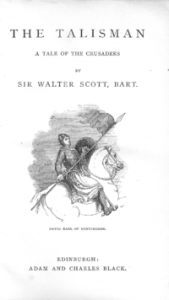 1832 – In his introduction (dated “1st July 1832”), Walter Scott states: “Prince David of Scotland, who was actually in the host [of Richard the Lionheart on crusade], and was the hero of some very romantic adventures on his way home, was also pressed into my service, and constitutes one of my dramatis personæ.”
1832 – In his introduction (dated “1st July 1832”), Walter Scott states: “Prince David of Scotland, who was actually in the host [of Richard the Lionheart on crusade], and was the hero of some very romantic adventures on his way home, was also pressed into my service, and constitutes one of my dramatis personæ.”
David Earl of Huntingdon, frontispiece to 1863 edition by A & C Black, On August 22nd and 23rd 1877, Wilford Woodruff, later reported that three knights, among others, Sir Walter Scott ‘called upon me, as an Apostle of the Lord Jesus Christ, in the Temple at St. George, two consecutive nights, and demanded at my hands that I should go forth and attend to the ordinances of the House of God for them.’ A high honor indeed!
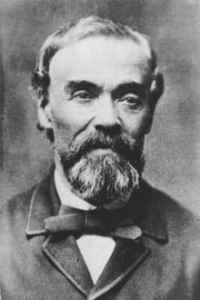 1844 Hugh Findlay (Newmilns, Ayrshire, Scotland, June 9, 1822 – March 2, 1900 in Fish Haven, Idaho, USA) was baptized in Dundee, Scotland, on July 1, 1844, by missionaries from The Church of Jesus Christ of Latter-day Saints. Hugh Findlay.
1844 Hugh Findlay (Newmilns, Ayrshire, Scotland, June 9, 1822 – March 2, 1900 in Fish Haven, Idaho, USA) was baptized in Dundee, Scotland, on July 1, 1844, by missionaries from The Church of Jesus Christ of Latter-day Saints. Hugh Findlay.
1849 all year long. The Great [Irish Potato] Famine, or an Gorta Mór, saw around one million people die and one million more emigrate from Ireland between 1845 and 1852. In 1851 nearly one-fifth of the populations of Glasgow and Dundee had been born in Ireland. Fewer than 100,000 came to Scotland, less than elsewhere, yet proportionately massive in a country of 2.8 million. Scotland during the famine years had been hit by industrial depression, cholera epidemics and a smaller scale famine in the Highlands. Irish immigrants brought a raft of contagious diseases.
http://www.heraldscotland.com/news/13086735.The_Great_Famine_and_Scotland/
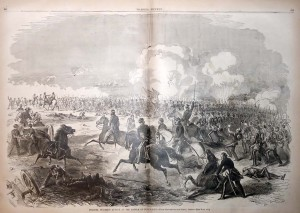 1861 American Civil War. Battle of Bull Run or Manassas. Lincoln’s Scots’ Generals – General McDowell – had the right of his Union army in motion around 2 am. McDowell’s divisions were attacking the weakest point on Beauregard’s line. The Union commander, General McDowell believed the day was won and rode up and down the lines yelling, “Victory! The day is ours!” later “General McDowell’s army in full retreat through Centerville. The day is lost. Save Washington and the remnants of the Army.”
1861 American Civil War. Battle of Bull Run or Manassas. Lincoln’s Scots’ Generals – General McDowell – had the right of his Union army in motion around 2 am. McDowell’s divisions were attacking the weakest point on Beauregard’s line. The Union commander, General McDowell believed the day was won and rode up and down the lines yelling, “Victory! The day is ours!” later “General McDowell’s army in full retreat through Centerville. The day is lost. Save Washington and the remnants of the Army.”
Colonel Hunter’s [clan Hunter] Attack at the Battle of Bull’s Run – From sketches by our Special artist. Harper’s Weekly. civilwardailygazette.com
1862 – American Civil War: the Battle of Malvern Hill takes place. It is the final battle in the Seven Days Campaign, part of George B. McClellan’s Peninsula Campaign.
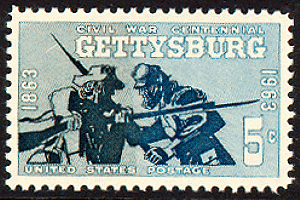 1863 Union & Confederate soldiers at Gettysburg.
1863 Union & Confederate soldiers at Gettysburg.
1963 July 1st. Civil War Centenary. General Robert E. Lee and 75,000 men took on General George G. Meade and 90,000 Union forces at Gettysburg, Pennsylvania, on July 1-3, 1863, in one of the most important battles of the Civil War. Strategically, Lee first tested the left side of the Union lines, then the right. On July 3rd, Gen. George Pickett led what has become the most infamous charge in American military history, of waste and incompetence. Pickett took 15,000 men against the center of the Union lines, and only 5,000 survived. The Confederacy had 20,000 casualties and lost 30,000 men. The North lost almost as many. The battle psychologically affected both sides, causing President Lincoln to come to Gettysburg and give what has become his famous address dedicating the cemetery there. The Battle of Gettysburg was fought during the same week that Gen. Ulysses S. Grant won at Vicksburg, which put the Confederates on the defensive in the east. usstampgallery.com
 1867 Nova Scotia co-founder of Canadian Confederation. The flag of Scotland features St Andrew’s saltire cross. The flag of Nova Scotia, created in 1858, is a banner of the coat of arms of Nova Scotia, which were granted to the Scottis colony by Charles I, in 1625. The flag of the modern Canadian province, a blue saltire on a white field, is a simple figure-ground reversal of the flag of Scotland (a white saltire, Saint Andrew’s cross, on a blue field), charged with an inescutcheon bearing the royal
1867 Nova Scotia co-founder of Canadian Confederation. The flag of Scotland features St Andrew’s saltire cross. The flag of Nova Scotia, created in 1858, is a banner of the coat of arms of Nova Scotia, which were granted to the Scottis colony by Charles I, in 1625. The flag of the modern Canadian province, a blue saltire on a white field, is a simple figure-ground reversal of the flag of Scotland (a white saltire, Saint Andrew’s cross, on a blue field), charged with an inescutcheon bearing the royal  arms of Scotland, a gold shield with a red lion rampant surrounded by a royal double tressure (a double border decorated with fleurs de lis). The royal arms do not appear on Scotland’s flag – they were added to Nova Scotia’s to distinguish the flag from the Naval Ensign of Russia which is also a blue saltire on a white field. The arms of the Scottish colony of Nova Scotia, granted in 1625.
arms of Scotland, a gold shield with a red lion rampant surrounded by a royal double tressure (a double border decorated with fleurs de lis). The royal arms do not appear on Scotland’s flag – they were added to Nova Scotia’s to distinguish the flag from the Naval Ensign of Russia which is also a blue saltire on a white field. The arms of the Scottish colony of Nova Scotia, granted in 1625.
1881 The Argyll and Sutherland Highlanders (Princess Louise’s) (1881 – 2006) 91st (Princess Louise’s Argyll shire) Regiment and the 93rd (Sutherland Highlanders) Regiment as outlined in the Childers Reforms. Wikipedia.
1884 Allan Pinkerton, the Scottish-born detective, died. Son of a Glasgow policeman, Pinkerton trained as a cooper before emigrating to the USA in 1842. Chief of US Secret Service during the American Civil War. The Pinkerton company logo was “We Never Sleep”, and emblazoned above the logo on the company headquarters was a huge black and white eye, which gave rise to the expression private eye. www.bbc.co.uk/scotland/history/onthisday/july/1
1899 fictional Dr. Henry Walton “Indiana” Jones, Jr., born Princeton, New Jersey, of Scots ancestry. By 1912, ‘Indiana’ holds the Life Rank as a Boy Scout in a Utah Troop. The sponsorship of the fictional troop is obscure. Local Latter Day Saint troops existed then. The Latter Day Saint church signed on with the Boy Scouts of America as a national Sponsor about 1913, and the life badge was adopted nationally as early as 1914.
 Young fictional Indiana Jones in The Last Crusade, played by River Phoenix. Life Rank cloth badge on the uniform above the right pocket. In 1912, fictional Indy (River Phoenix) as a Boy Scout attempts to retrieve the fictional Cross of Coronado from treasure hunters. The fictional Cross of Coronado was a jewel-encrusted golden crucifix with a chain; named for historical Spanish explorer Francisco Vásquez de Coronado and contained a piece of the cross. The plot’s provenance was the cross was given to Coronado in 1520 by the historical Spanish conquistador, Hernando Cortés, and later buried in a cave in Utah.
Young fictional Indiana Jones in The Last Crusade, played by River Phoenix. Life Rank cloth badge on the uniform above the right pocket. In 1912, fictional Indy (River Phoenix) as a Boy Scout attempts to retrieve the fictional Cross of Coronado from treasure hunters. The fictional Cross of Coronado was a jewel-encrusted golden crucifix with a chain; named for historical Spanish explorer Francisco Vásquez de Coronado and contained a piece of the cross. The plot’s provenance was the cross was given to Coronado in 1520 by the historical Spanish conquistador, Hernando Cortés, and later buried in a cave in Utah.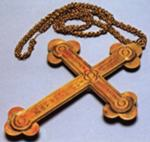 the back of the fictional movie cross. indianajones.wikia.com/wiki/Cross_of_Coronado
the back of the fictional movie cross. indianajones.wikia.com/wiki/Cross_of_Coronado
1902: Scrooge McDuck (fictional Clan McDuck) returns to Scotland to get his sisters Matilda McDuck and Hortense McDuck to come to America with him. Also in 1902, Scrooge’s father Fergus McDuck dies, aged 67, in Dismal Downs. Scrooge, Matilda and Hortense are the last of the McDuck clan. Scrooge settles in the small village of Duckburg, Calisota, USA which he chose as his home base.
1903 Scottish Conservative politician, Sir Alec Douglas-Home, was born. Prime minister from October 1964 to October 1964. www.bbc.co.uk/scotland/history/onthisday/july/2
1916 William Forbes-Sempill, 17th Lord Sempill, son Robert was killed in the Battle of the Somme serving with the Gordon Highlanders.
1916 France. Turnbull clan, Winston Churchill himself wrote on this defense in his book stating: On 1 July 1916 at Leipzig Salient, Authuille, France, Sergeant [James Youll] Turnbull’s party captured a post of apparent importance to the enemy who immediately began heavy counter-attacks, which were continued throughout the day. Although his party was wiped out and replaced several times, Sergeant Turnbull never wavered in his determination to hold the post, the loss of which 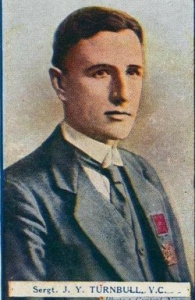 would have been very serious. Almost single-handed he maintained his position, displaying the highest degree of valour and skill in the performance of his duty. Later in the day he was killed [age 32] while engaged in a bombing counter-attack. The Germans were said, after seeing the body of Turnbull in his uniform kilt, to call him and all Scots “The Devils in Dress” and “Ladies from Hell!”. Wikipedia. Battle of the Somme Battle Honours.
would have been very serious. Almost single-handed he maintained his position, displaying the highest degree of valour and skill in the performance of his duty. Later in the day he was killed [age 32] while engaged in a bombing counter-attack. The Germans were said, after seeing the body of Turnbull in his uniform kilt, to call him and all Scots “The Devils in Dress” and “Ladies from Hell!”. Wikipedia. Battle of the Somme Battle Honours.
 During World War I, the 25 battalions of the Black Watch fought mainly in France and Flanders. Sergeant J.Y.Turnbull (Glasgow Dec 24, 1883 to July 1, 1916 Liepzig Salient France) Victoria Cross.
During World War I, the 25 battalions of the Black Watch fought mainly in France and Flanders. Sergeant J.Y.Turnbull (Glasgow Dec 24, 1883 to July 1, 1916 Liepzig Salient France) Victoria Cross.
- North Atlantic. ‘Their Finest Hour, The Fall of France, Back to France.’ Generations of Government gun control and gun bans had disarmed the homefronts of Poles, and disarmed the homefronts of neutral Belgians and Dutch, and disarmed the homefronts of French, Scots, and English. Relying, as their governments promised and they falsely supposed on their police and armies. All were to pay very dearly for such short sightedness, under rape, riot, and ruin. Terrible and crushing evils would be unleashed on a defenseless, helpless and self unarmed populace. The shock of Nazi blitzkrieg devastated Poland, Belgium, Netherlands, Luxembourg, and France. Next up was Great Britain. Churchill (clan Montgomery) wrote –
- They never had need to repent of it. we ferried these precious weapons safely across the Atlantic during July, and they formed not only a material gain, but an important factor in all calculations made by friend or foe about invasion.
600 Freight cars loaded with American guns, field guns, machine guns, ammo, shells, cartridges, are on a dozen British merchant Marine ships crossing the Atlantic, zigzagging to avoid Nazi submarines. Backstory, the British evacuation of Dunkirk (May June 1940) and other evacuations from Brest, Cherbourg, St. Malo, and St. Nazaire, left all their guns and equipment on the beaches of France. The United States sold a half million rifles and more to restock and rearm Scotland and England against a threatened Nazi invasion upcoming in the Battle of Britain (June to November 1940).
 1958 An Affair to Remember’ date made on the Constitution between Deborah Kerr and Cary Grant, on the 102nd floor of the Empire State Building, New York City.
1958 An Affair to Remember’ date made on the Constitution between Deborah Kerr and Cary Grant, on the 102nd floor of the Empire State Building, New York City.
Kerr Crest: The sun in his spledour Or. Motto: SERO SED SERIO. [“Late but in earnest”]. Chief: Michael Andrew Foster Jude Kerr, 13th Marquess of Lothian
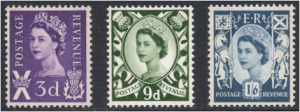 1999 – The Scottish Parliament is officially opened by Queen Elizabeth II on the day that legislative powers are officially transferred from the old Scottish Office in London to the new devolved Scottish Executive in Edinburgh. Elizabeth II.
1999 – The Scottish Parliament is officially opened by Queen Elizabeth II on the day that legislative powers are officially transferred from the old Scottish Office in London to the new devolved Scottish Executive in Edinburgh. Elizabeth II.
2011 Humor. McCullough was drinking at a pub all night. When he got up to leave, he fell flat on his face. He tried to stand again, but to no avail, falling flat on his face. McCullough crawled outside to get some fresh air to see whether that would sober him up. Once outside, he stood up and, sure enough, fell flat on his face. So, he crawled all the way home, thru the front door, through the door into his bedroom, then into his bed, and was sound asleep as soon as his head hit the pillow. McCullough woke the next morning to his wife shouting, “So, ye’ve been oot drinkin’ as usual!” “Why would ye say that?” he defended innocently. “Because the pub called an’ ye left yer wheelchair there again!”
http://www.scotlandvacations.com/scottishhumour.htm
Trump has plans to open Scottish course A fair way to go – Trump, far left, marches down the fairway for the first time July 9, accompanied by Colin Montgomerie . Aberdeen. http://i2.cdn.turner.com/cnnnext/dam/assets/120710043935-a-fair-way-to-go-horizontal-large-gallery.jpg Great Grandson of Alexander MacLeod, a crofter and fisherman, was born 10 May 1830 in Stornoway, Ross, Scotland to William MacLeod and Christian MacLeod. Alexander died in Tong, Stornoway, of cancer on 12 January 1900 at the age of 69.
http://genealogy.about.com/od/famous_family_trees/p/trump_2.htm
Great grandparents of Donald John Trump Senior, and Junior.
![]() 2014 Halifax Canada was named for the Lord Halifax, whose title came from Halifax Yorkshire.
2014 Halifax Canada was named for the Lord Halifax, whose title came from Halifax Yorkshire.
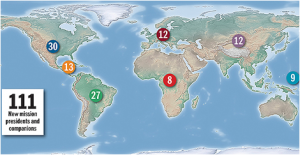 2018 The First Presidency has called 111 new mission presidents, effective July 2018. Scotland/Ireland Mark A. and Denise R. Macdonald
2018 The First Presidency has called 111 new mission presidents, effective July 2018. Scotland/Ireland Mark A. and Denise R. Macdonald
Disclaimer: The author of each article published on this web site owns his or her own words. The opinions, beliefs and viewpoints expressed by the various authors and forum participants on this site do not necessarily reflect the opinions, beliefs and viewpoints of Utah Standard News or official policies of the USN and may actually reflect positions that USN actively opposes. No claim in public domain or fair use. © John Choate
Utah Standard News depends on the support of readers like you.
Good Journalism requires time, expertise, passion and money. We know you appreciate the coverage here. Please help us to continue as an alternative news website by becoming a subscriber or making a donation. To learn more about our subscription options or make a donation, click here.
To Advertise on UtahStandardNews.com, please contact us at: ed@utahstandardnews.com.




Comments - No Responses to “July 1st Scots Book of Days”
Sure is empty down here...